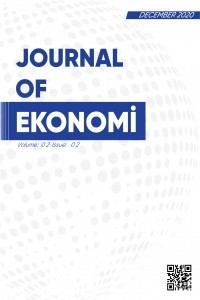Analysis of Turkey's classic and financial kuznets curves in regards to the level of development and increased distribution
Analysis of Turkey's classic and financial kuznets curves in regards to the level of development and increased distribution
Income Distribution, Financial Kuznets ARDL Boundary Test,
___
- Altunöz U. (2013). Türkiye’de Enflasyon, Büyüme ve Finansal Derinleşme İlişkisinin Ampirik Analizi, Sütçüimam Üniversitesi İİBF Dergisi, sayı 2: 175-194.
- Altunöz,U.(2015). Tüketim Fonksiyonu ve Türkiye İçin Gelir Tüketim İlişkisinin Ampirik Analizi. International Conference on Euroasian Economies, 871-875.
- Altunöz,U.(2021). Finansal Gelişmişlik ve Gelir Dağılımı Bağlamında Türkiye’nin Finansal Kuznets Eğrisi. ISPEC Uluslararası Multisdisiplin Çalışmaları Kongresi, 115-129.
- Ang, J.B. (2008). Finance and Inequality: The Case of India, Monash University, Department of Economics, Discussion Paper, No. 8, 1-25
- Brown, R.,L, James D. ve Jonathan M. E. (1975). Tech-niques for Testing the Constancy of Regression Relationships over Time, Journal of the Royal Statistical Society, 37(2), 149-192.
- Chen, B-L. (2003). An inverted-U Relationship between Inequality and Longrun Growth, Economic Letters, 78(2), 205-212.
- Çay Atalay, A. ve Akan, Y. (2023). OECD Ülkelerinin Yeşil Ekonomi Verilerinin Çevresel Kuznets Eğrisi Hipotezine Göre Test Edilmesi . Trends in Business and Economics , 37 (1) , 57-67 .
- Demir, C.(2020). Lorenz Eğrisi ve Gelir Adaleti Analizi,(Çevrim içi), https://www.matematiksel.org/gelir-dagilimi-adaletsizligi/, Erişim:8.10.2022.
- Destek, M. A., Okumuş, İ., ve Manga, M. (2017). Türkiye’de Finansal Gelişim ve Gelir Dağılımı İlişkisi: Finansal Kuznets Eğrisi, Doğuş Üniversitesi Dergisi, 18(2), 153-165.
- Dumlu, U. ve Aydın, Ö.((2008). Ekonometrik Modellerle Türkiye için 2006 Yılı Gini Katsayısı Tahmini, Ege Akademik Bakış, 8 (1), 373-393
- Dumrul, C. , İlkay, S. Ç. ve Dumrul, Y. (2021). Finansal Kuznets Eğrisi Hipotezi: Yapısal Kırılmalı Eş-bütünleşme Testleri ile Türk Ekonomisine İlişkin Ampirik Bir Analiz . Sosyoekonomi , 29 (50) , 337-359.
- Efeoğlu, R. (2022). Yeni Sanayileşen Ülkelerde Finansal Kuznets Eğrisinin Geçerliliği . Uluslararası Ekonomi ve Yenilik Dergisi , 8 (1) , 19-34 .
- Galor, O. ve J. Zeira (1993). Income Distribution And Macroeconomics, The Review of Economic Studies, 60(1), 35–52.
- Gini, C.(1912). Variabilit`a e Mutabilit`a, Bologna: Tipografia di Paolo Cuppini.
- Göğül, P.K.(2012). Düşük Gelirli Bireylerin Gelir Dağılımı ve Yoksulluk Sorununa Yönelik Kamu Politikası Algısı: Diyarbakır Örneği, İstanbul Üniversitesi Sosyal Bilimler Enstitüsü, Yayımlanmamış Doktora Tezi.
- Greenwood, J. and B. Jovanovic (1990). Financial Development, Growth and The Distribution of Income, The Journal of Political Economy, 98 (5), 1076–1107.
- Hepsağ, A. (2017). Finansal Kuznets Eğrisi Hipotezi: G-7 Ülkeleri Örneği. Sosyal Güvenlik Dergisi (Journal of Social Security). 7(2), 135-156.
- Hoi, C. M., ve Hoi, L. Q. (2013). Financial Development and IncomeInequality in Vietnam: An Empirical Analysis. Bangladesh Journal of Pharmacology, 8(4), 361-364.
- İmamoğlu, H. & Çağlar Onbaşıoğlu, D. (2023). Küreselleşmenin Çevresel Kuznets Eğrisi Hipotezi Üzerindeki Rolü: Pakistan Örneği . Trends in Business and Economics , 37 (3) , 177-185 .
- Kubar, Y . (2011). Bir İktisat Politikası Amacı Olarak Gelir Dağılımı: Türkiye Örneği (1994–2007) Analizi, Kahramanmaraş Sütçü İmam Üniversitesi İktisadi ve İdari Bilimler Fakültesi Dergisi , 1 (2) , 227-246 .
- Kuznets, S. (1955). Economic Growth and Ineome Inequality , American Economic Review, 45-1, 1-28.
- Law, S.H ve Tan, H.Y.B (2009). The Role of Financial Development on IncomeInequality in Malaysia, Journal of Economic Development 34(2), 153- 168.
- Lorenz, M. O. (1905). Methods of Measuring the Concentration of Wealth. Publication of the American Statistical Association, 9, 209–219.
- Malinen T. (2012), “Estimating the long-run relationship between income inequality and economic development”. Empirical Economics, forthcoming.
- Özdemir, O. (2021). Finansal Kuznets Eğrisi ve Ekonomik Küreselleşme İlişkisi Üzerine: OECD Ülkeleri İçin Gelir Eşitsizliği Temelli Bir Analiz . OPUS International Journal of Society Researches , 17 (38) , 5271-5303 .
- Park, D., veShin, K. (2015). Economic Growth, Financial Development, and Income Inequality. Asian Development Bank Economics Working Paper Series, (441).
- Pata, U. K. (2020). Finansal Gelişmenin Gelir Eşitsizliği Üzerindeki Etkileri: Finansal Kuznets Eğrisi Hipotezi Türkiye İçin Geçerli mi? . Atatürk Üniversitesi İktisadi ve İdari Bilimler Dergisi , 34 (3) , 809-828 .
- Perron, P. (1989). The Great Crash, the Oil Price Shock, and the Unit Root Hypothesis, Econometrica, 57(6), 1361-1401.
- Pesaran, M. H., Shin, Y. ve R. J. Smith (2001). Bounds Testing Approaches to the Analysis of Level Relationships, Journal of Applied Econometrics, 16(3), 289-326.
- Phillips, P.C.B. and Perron, P. (1988). Testing for a Unit Root in Time Series Regression. Biometrika, 75, 335-346.
- Topuz,S.G. ve Dağdemir,Ö.(2016). Ekonomik Büyüme ve Gelir Eşitsizliği İlişkisi: Kuznets Ters-U Hipotezi’nin Geçerliliği, Eskişehir Osmangazi Üniversitesi İİBF Dergisi, 11(3),115-130.
- Torusdağ, M. ve Barut, A. (2020). Çevresel ve Finansal Kuznets Eğrisinin Geçerliliği: Türkiye Örneği . Maliye Araştırmaları Dergisi , 6 (3) , 125-135 .
- TÜİK (2022). Gelir ve Yaşam Koşulları Araştırması, 2021, (çevrim içi), https://data.tuik.gov.tr/Bulten/Index?p=Gelir-ve-Yasam-Kosullari-Arastirmasi-2021., Erişim Tarihi.8.10.2022.
- Zivot, E. ve Andrews, D. (1992). Further Evidence on the Great Crash, the Oil-Price Shock, and the Unit-Root Hypothesis, Journal of Business-Economic Statistics, 10, 3, 251-270.
- Yayın Aralığı: Yılda 2 Sayı
- Başlangıç: 2019
- Yayıncı: Cem IŞIK
Sevgi SUMERLİ SARIGÜL, Merve ÜNLÜ, Pınar AVCI, Esra YAŞAR
Human resource accounting disclosure (HRAD) practices: Evidence from banking industry in Bangladesh
Aminul ISLAM, Md. Mazharul ALAM, Hasibul ISLAM
Bibliometric analysis and mapping with vosviewer in neet-head research in social sciences
